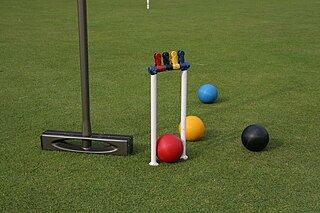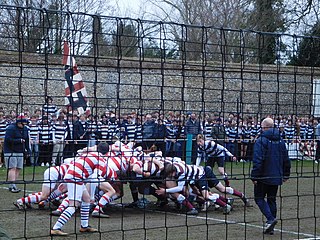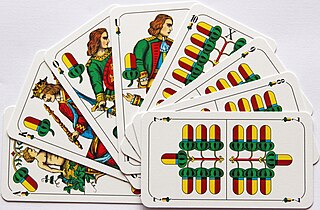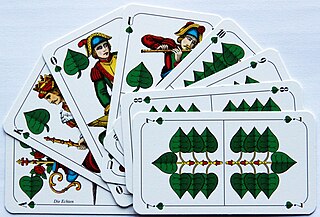
Croquet is a sport that involves hitting wooden or plastic balls with a mallet through hoops embedded in a grass playing court.

Capture the Flag (CTF) is a traditional outdoor sport where two or more teams each have a flag and the objective is to capture the other team's flag, located at the team's "base", and bring it safely back to their own base. Enemy players can be "tagged" by players when out of their home territory and, depending on the rules, they may be out of the game, become members of the opposite team, be sent back to their own territory, be frozen in place, or be sent to "jail" until freed by a member of their own team.

Tag is a playground game involving one or more players chasing other players in an attempt to "tag" and mark them out of play, typically by touching with a hand. There are many variations; most forms have no teams, scores, or equipment. Usually when a person is tagged, the tagger says, "It!" or "Tag, you're 'It'!" The last one tagged during tag is "It" for the next round. The game is known by other names in various parts of the world, including "running and catching" in India and "catch and cook" in the Middle East.

Kick the can, is an outdoor children's game related to tag, hide and seek, and capture the flag, played with as few as three to as many as several dozen players. The game is one of skill, strategy, stealth, and stamina.

Winchester College football, also known as Winkies, is a code of football played at Winchester College. Its rules make it somewhat resemble rugby football but with a round football and little handling of the ball. It was once played in South Africa, but is now restricted to the community directly connected to Winchester College. The game's season is January–March, the second term of the academic year. It developed from an unstructured street game of the 17th century into a standardised sport by the early 19th century. This was first played on the top of St. Catherine's Hill with a line of junior boys down each side to keep the ball from rolling away. The game was moved to the College's playing fields, and the lines of boys were replaced with netting.

Kickball is a team sport and league game, similar to baseball. Like baseball, it is a safe haven game in which one team tries to score by having its players return a ball from home base to the field and then circle the bases. Meanwhile, the other team tries to stop them by tagging them "out" with the ball before they can return to the home base. However, instead of hitting a small, hard ball with a bat, players kick an inflated rubber ball; this makes it more accessible to young children. As in baseball, teams alternate half-innings. The team with the most runs after a predefined number of innings wins.

A street game or street sport is a sport or game that is played on city streets rather than a prepared field. Street games are usually simply play time activities for children in the most convenient venue. Some street games have risen to the level of organized tournaments, such as stickball.

Hoop rolling, also called hoop trundling, is both a sport and a child's game in which a large hoop is rolled along the ground, generally by means of an object wielded by the player. The aim of the game is to keep the hoop upright for long periods of time, or to do various tricks.

British Bulldog is a tag-based playground and sporting game, commonly played in schoolyards and on athletic fields in the UK, Canada, South Africa, Australia, and related Commonwealth countries, as well as in the U.S. and Ireland. The object of the game is for one player to attempt to intercept other players who are obliged to run from one designated area to another. British Bulldog is characterised by its physicality and is often regarded as violent, leading it to be banned from many schools due to injuries to the participants.
Darebase or dare base, also known as prisoners' baseChevy Chace, or Release the Prisoner and originally as bars, base or prisoners' bars, is a tag game between two or more teams on an open field that places a premium on speed and agility. Darebase holds some similarity to capture the flag in its basic premise of chase, capture, and conquer. It differs in that the game field consists of a large no-man's land with team bases occupying two opposite ends of the field and in the methods of achieving victory. A variation called stealbase uses an object that may be either touched or stolen to achieve victory.

Duck, duck, goose is a traditional children's game often first learned in preschool or kindergarten. The game may be later adapted on the playground for early elementary students. The object of this game is to walk in a circle, tapping on each player's head until one is finally chosen; the chosen player must then chase the picker to avoid becoming the next picker.
Elfern or Elfmandeln, is a very old, German and Austrian 6-card, no-trump, trick-and-draw game for two players using a 32-card, French-suited Piquet pack or German-suited Skat pack. The object is to win the majority of the 20 honours: the Ace, King, Queen, Jack and Ten in a Piquet pack or the Ace, King, Ober, Unter and Ten in a Skat pack. Elfern is at least 250 years old and a possible ancestor to the Marriage family of card games, yet it is still played by German children.
Réunion, Reunion or Vereinigungsspiel is an historical German point-trick game for three players which, despite its French name, appears to have originated in the central Rhineland and lowland areas to the east. It is a 10-card game of the ace–ten family and uses a 32-card French-suited piquet pack or 32-card Skat pack. Players who cannot follow suit must trump. Otherwise the game can be described as a simplified version of Skat, but is also reminiscent of Euchre with its two permanent top trumps, the Right and Left Bowers.

German Solo or just Solo is a German 8-card plain-trick game for 4 individual players using a 32-card, German- or French-suited Skat pack. It is essentially a simplification of Quadrille, itself a 4-player adaptation of Ombre. As in Quadrille, players bid for the privilege of declaring trumps and deciding whether to play alone or with a partner. Along with Ombre, Tarock and Schafkopf, German Solo influenced the development of Skat. Parlett calls it a "neat little descendant of Quadrille" and "a pleasant introduction" to the Ombre family of games.
Poison is a traditional children's game, a variant of the game of tag. Jessie H. Bancroft's 1909 book Games for the Playground... describes it as follows.

Brandeln is an historical card game for three or four players; in which the winning bidder plays alone against the rest. It is one of the earliest games to use the terms Bettel – a contract to lose every trick – and Mord - a contract to win every trick. One of several card games mastered by Mozart, Brandeln is still current in Austria and Germany today. It has been described as having a "civilized, refined and ingenious character" and "one of the most pleasant card games".

Wallachen is an Old Bavarian card game, which used to be very popular in eastern Bavaria. Although, by 2012, it had become a rarer sight at pub tables, there have been more recent moves to revive it. Wallachen is a relatively simple three-hander that is easy to learn. As a result, like Grasobern, it has a relatively relaxed character without the mental demands of Schafkopf or the psychological stress of Watten. It is a member of the Préférence family of card games.

Sticheln is an easy-to-learn, trick-taking, card game for 4 players that originated from Austria. It is an old game, being recorded as early as 1756 and its rules being first described in 1830. The name means "playing [for] tricks".
Bierlachs, also Bierskat, Bierscat, Lachs or Beer Skat, is a variant of Germany's national card game, Skat, in which the winner is the first to score a fixed number of points. It is predominantly played for beer in pubs and restaurants.















